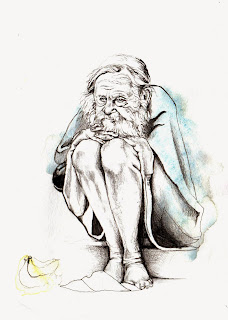Monday, 24 November 2014
Sunday, 23 November 2014
http://www.ashevillenc.gov/Portals/0/city-documents/planning/homeless/National%20Law%20Center%20Myths%20and%20Facts.pdf
Substance Abuse and Mental Illness
Myth: All homeless people are mentally ill or substance abusers.
Fact: Around a quarter of homeless people are mentally ill, and about 40% are alcohol or substance abusers, with around 15% suffering both disabilities.
Koegel has researched the prevalence of mental illness among the homeless population and found "between 20% and 25% of those homeless people studied have at some time experienced severe and often extremely disabling mental illnesses such as schizophrenia and the major affective disorders (clinical depression or bipolar disorder)."9
James Wright, of Tulane University, has studied the prevalence of alcohol and other drug abuse among the homeless population. He finds that 38% of homeless people are alcohol abusers, as opposed to 10% of the general population. He furthermore finds that 13% of homeless people are drug abusers.10
The Center for Mental Health Services states that betweeen10 and 20% of homeless people suffer "co-occurring severe mental and substance use disorders."11
Substance Abuse and Mental Illness
Myth: All homeless people are mentally ill or substance abusers.
Fact: Around a quarter of homeless people are mentally ill, and about 40% are alcohol or substance abusers, with around 15% suffering both disabilities.
Koegel has researched the prevalence of mental illness among the homeless population and found "between 20% and 25% of those homeless people studied have at some time experienced severe and often extremely disabling mental illnesses such as schizophrenia and the major affective disorders (clinical depression or bipolar disorder)."9
James Wright, of Tulane University, has studied the prevalence of alcohol and other drug abuse among the homeless population. He finds that 38% of homeless people are alcohol abusers, as opposed to 10% of the general population. He furthermore finds that 13% of homeless people are drug abusers.10
The Center for Mental Health Services states that betweeen10 and 20% of homeless people suffer "co-occurring severe mental and substance use disorders."11
-
Homeless Population Demographics
Myth: Homeless people are mostly single men.
Fact: Families constitute a large and growing percentage of the homeless population.
A recent study found that families comprise 38% of the urban homeless population.5 Other research finds that homeless families comprise the majority of homeless people in rural areas.6
Employment
Myth: Homeless people don't work and get most of their money from public assistance programs.
Fact: Homeless people do work, and a relatively small percentage of them receive government assistance.
A nationwide study by the Urban Institute in 1987 found that only 20% of 1,704 homeless people received AFDC, GA, or SSI.7
The Chronic Theory
Myth: Homeless people are a fixed population who are usually homeless for long periods of time.
Fact: The homeless population is quite diverse in terms of their length of homelessness and the number of times they cycle in and out of homelessness.
Research on the length of homelessness states that 40% of homeless people have been homeless less than six months, and that 70% of homeless people have been homeless less than two years.3
-
transitionally homeless who have a single episode of homelessness lasting an average of
58 days,
-
episodically homeless who have four to five episodes of homelessness lasting a total of
265 days,
-
chronically homeless who have an average of two episodes, lasting a total of 650 days.4
references
-
James Wright, Memo to NLCHP: Transiency of Homeless Substance Abusers 1 (March 11, 1997)
-
Martha Burt, What We Know About Helping the Homeless and What It Means For HUD's Homeless Programs
Testimony presented to the Housing and Community Development Subcommittee of the Banking and Financial
Institutions Committee of the U.S. House of Representatives 1 (March 5, 1997).
-
Dennis Culhane, Testimony presented to the Housing and Community Development Subcommittee of the Pamela
Fischer, Criminal Activity Among the Homeless: A Study of Arrests in Baltimore 49 (January, 1988).
-
Banking and Financial Institutions Committee of the U.S. House of Representatives, Figure 3 (March 5, 1997).
-
U.S. Conference of Mayors, A Status Report on Hunger and Homelessness in America's Cities:1996 (1996)
-
Yvonne Vissing, Out of Sight, Out of Mind: Homeless Children and Families in Small Town America, 1996 (1996).
-
Martha Burt and Cohen, America's Homeless: Numbers, Characteristics, and Programs that Serve Them 43 (1989).
-
Peter Rossi, Down and Out in America 40 (1989).
-
Paul Koegel, Causes of Homelessness, Homelessness in America 31 (1996).
-
James Wright, Homelessness and Health 68 (1987).
-
Substance Abuse and Mental Health Services Administration, Center for Mental Health Services, U.S. Department of
Health and Human Services, Integrating Mental Health and Substance Abuse Services for Homeless People with Co- Occurring Mental and Substance Use Disorders 1.
-
James Wright, Memo to NLCHP: Transiency of Homeless Substance Abusers 1 (March 11, 1997)
-
transitionally homeless who have a single episode of homelessness lasting an average of
58 days,
Wednesday, 19 November 2014
http://www.conserve-energy-future.com
http://www.stgeorgescrypt.org.uk/charity/index.php/component/k2/item/412-world-homeless-day
proposal
negative rep- analyse
how they are presented
limited
sterotypical
created more rounded human representations
newspaers
news
films
grayson perry on class
iplayer
lazily stereoptype - becoming more human to unround them.
how are the homeless represented in british society.
http://www.stgeorgescrypt.org.uk/charity/index.php/component/k2/item/412-world-homeless-day
proposal
negative rep- analyse
how they are presented
limited
sterotypical
created more rounded human representations
newspaers
news
films
grayson perry on class
iplayer
lazily stereoptype - becoming more human to unround them.
how are the homeless represented in british society.
Thursday, 13 November 2014
consumerism, persuasion, society, brand and quality lecture
naomi klein- no logo 1999
adam curtis-century of self
edward bernays - freuds nephew
employed by american government during war
employed as a propagandist
taking understanding of our repressed desires - he's innovation was taking this human nature of what they desire and make people think there desires are met when they buy things -public relations
eg. he's work for cigarette companies - early successes, trying to get past what was a social taboo of women smoking in society- was viewed negatively for young/cultured woman
lighting up 'torches of freedom' display of freedom and power, independence for woman - it then become very popular with woman as they linked it to being- independent, free etc
product placement
celebrity
endorsements
the use of pseudoscientific reports
'more doctors smoke camels than another cigarettes'
fordism
henry ford (1863-1947)
created affluence for society - felt by big businesses and workers
more products being produced....
branding: becomes important for companies to distinguish there product from other companies products
shift from a need culture to a desire culture - things are no longer sold on the basis that you 'need' them- more because we desire them.
vance packard- the hidden persuaders- he finds 8 common technique companies use to make people irashionly need the product.
giving people the 'illusion of freedom' - freedom of choice, democratic society where they can choose who/what they want to be.
rise of communism
the stop market crash- led the the great depression - unemployment etc
political class- roosevelt and the 'new deal' (1933-36) start to regulate markets again, increase taxation of big business and send that money to the poorer people - creating farer society.
'democracity'
consumerism is an idealogical project
we must believe that through consumption our desires can be met
the consumer self
the legacy of bernays /pr can be felt in al aspects of c21st society
adam curtis-century of self
edward bernays - freuds nephew
employed by american government during war
employed as a propagandist
taking understanding of our repressed desires - he's innovation was taking this human nature of what they desire and make people think there desires are met when they buy things -public relations
eg. he's work for cigarette companies - early successes, trying to get past what was a social taboo of women smoking in society- was viewed negatively for young/cultured woman
lighting up 'torches of freedom' display of freedom and power, independence for woman - it then become very popular with woman as they linked it to being- independent, free etc
product placement
celebrity
endorsements
the use of pseudoscientific reports
'more doctors smoke camels than another cigarettes'
fordism
henry ford (1863-1947)
created affluence for society - felt by big businesses and workers
more products being produced....
branding: becomes important for companies to distinguish there product from other companies products
shift from a need culture to a desire culture - things are no longer sold on the basis that you 'need' them- more because we desire them.
vance packard- the hidden persuaders- he finds 8 common technique companies use to make people irashionly need the product.
- selling emotional security
- selling the reassurance of worth
- "" ego-gratification
- "" creative outlet
- "" love onjects
- "" sense of power
- ""sense of roots
walter lippmann- public opinion - a new elite is needed to manage the bewildered herd
'manufactuing consent'
giving people the 'illusion of freedom' - freedom of choice, democratic society where they can choose who/what they want to be.
rise of communism
the stop market crash- led the the great depression - unemployment etc
political class- roosevelt and the 'new deal' (1933-36) start to regulate markets again, increase taxation of big business and send that money to the poorer people - creating farer society.
'democracity'
consumerism is an idealogical project
we must believe that through consumption our desires can be met
the consumer self
the legacy of bernays /pr can be felt in al aspects of c21st society
Tuesday, 11 November 2014
study Task 1 (practical )drawings - inspired by artists and favourite development pieces
 |
| after researching into food banks, i was inspired to look in my own cupboards to find the foods that are sort of my essential survival items when i can't afford the luxuries! |
 |
| to add a stronger context and concept to this piece i have i subtly collaged receipts from supermarkets into the mans clothing - ironic message as he can not afford to buy food. |
playing around with illustration styles
Friday, 7 November 2014
Cop 2 practical task
this morning we were put in groups and sent to a destination (leeds arts gallery) To take part in a drawing task. we had to sit in the cafe and record modern and historial aspects in the room using different drawing techniques and different papers. i drew things such as the old tiling and sculptures for the old and things likes coke cans, modern chair designs, plants for modern aspects.
 |
| when we came back from the galleries we had a hour to put together all of our observational work and create a ................ |
 |
| 2 different tones of voices. |
 |
| i also thought the combination of surface pattern and detail works really well as you could see the pattern through the tracing paper. |
Subscribe to:
Comments (Atom)













